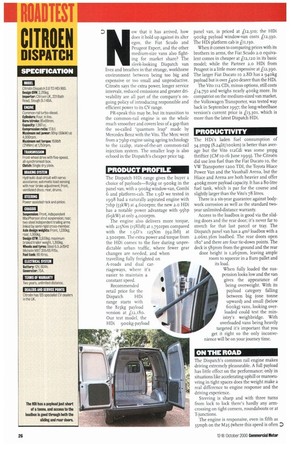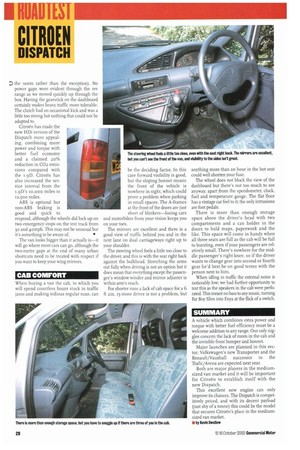ow that it has arrived, how does it hold up
Page 28

Page 30

If you've noticed an error in this article please click here to report it so we can fix it.
against its alter egos, the Fiat Scudo and Peugeot Expert, and the other medium-size vans also fighting for market share? The sleek-looking Dispatch van lives and breathes in that strange, workhorse environment between being too big and expensive or too small and unproductive. Citroen says the extra power, longer service intervals, reduced emissions and greater driveability are all part of the company's ongoing policy of introducing responsible and efficient power to its CV range.
PR-speak this may be, but its transition to the common-rail engine is on the whole much smoother and covers less of a gap than the so-called "quantum leap" made by Mercedes Benz with the Vito. The Mere went from a 79hp engine using ageing technology to the 122hp, state-of-the-art common-rail injection system. The smaller leap is also echoed in the Dispatch's cheaper price tag.
PRODUCT PROFILE
The Dispatch H Di range gives the buyer a choice of payloads-815kg or 9 ookg in the panel van, with a 900kg window-van, Combi 6 and platform-cab. The I.9D we tested in 1998 had a naturally aspirated engine with 7rhp (53kW) at 4,600rpm; the new 2.0 HDi has a notable power advantage with 95hp (69kW) at only 4,000rpm.
The engine also delivers more torque, with .2.15Nm (t581bft) at 1,750rpm compared with the 1.9 D's 125Nm (92.1bft) at 2,5oorpm. The extra power and torque from the HDi comes to the fore during unpredictable urban traffic, where fewer gear changes are needed, and when travelling fully freighted on A-roads and dual car riageways, where it's easier to maintain a constant speed. Recommended retail price for the
Dispatch H Di range starts with the 815kg payload version at £12,180. Our test model, the HDi 900kg-payload
panel van, is priced at £12,310; the HDi 900kg payload window-van costs £12,330. The HDi platform cab is pr,13o.
When it comes to comparing prices with its brothers in arms, the Fiat Scudo 2.0 equivalent comes in cheaper at iI2,120 in its basic model; while the Partner 2.o HDi from Peugeot is a little more expensive at £12,390. The larger Fiat Ducato to 2.8D has a 940kg payload but is over £400 dearer than the HDi.
The Vito TI2 CDi, minus options, still costs £14,75o and weighs nearly 400kg more. Its compatriot on the medium-sized van market. the Volkswagen Transporter, was tested way back in September 1997; the long-wheelbase version's current price is £53,305, which is more than the latest Dispatch H Di.
PRODUCTIVITY
The HDi's laden fuel consumption of 34.3mpg (8.241it/iookm) is better than average but the Vito ir2Cdi was some 3mpg thriftier (CM ro-i6 June 1999). The Citroen did use less fuel than the Fiat Ducato to, the VW Transporter 1200 TDI, the Toyota Hiace Power Van and the Vauxhall Arena, but the Hiace and Arena are both heavier and offer 400kg more payload capacity. It has a 8o-litre fuel tank, which is par for the course and slightly larger than the Vito's 78 litres.
There is a six-year guarantee against bodywork corrosion as well as the standard twoyear unlimited-distance warranty.
Access to the loadbox is good via the sliding doors and the rear door; it's never far to stretch for that last parcel or tray. The Dispatch panel van has a 41113 loadbox with a 2.063(1.36m loadbed. The rear doors open r8o° and there are four tie-down points. The deck is 585mm from the ground and the rear door height is 1,265mm, leaving ample room to squeeze in a Euro pallet and its load.
When fully loaded the suspension looks low and the van gives the appearance of being overweight. With its payload category falling between big (one tonne upward) and small (below 600kg) vans, looking over loaded could test the ministry's weighbridge. With overloaded vans being heavily targeted it's important that you get it right so the only inconvenience will be on your journey time.
ON THE ROAD
The Dispatch's common rail engine makes driving extremely pleasurable. A full payload has little effect on the performance; only in situations like accelerating uphill or manoeuvring in tight spaces does the weight make a real difference to engine response and the driving experience.
Steering is sharp and with three turns from lock to lock there's hardly any armcrossing on tight corners, roundabouts or at T-junctions.
The engine is responsive, even in fifth as 35mph on the M25 (where this speed is often
D the norm rather than the exception). No power gaps were evident through the rev range as we moved quickly up through the box. Having the gearstick on the dashboard certainly makes heavy traffic more tolerable. The clutch had an occasional kick and was a little too strong but nothing that could not be adapted to.
Citroen has made the new HDi version of the Dispatch more appealing, combining more power and torque with better fuel economy and a claimed zo% reduction in CO2 emissions compared with the 1.9D. Citroen has also increased the service interval from the 1.9 D's io,000 miles to r 2,5 o o miles.
ABS is optional but non-ABS braking is good and quick to respond, although the wheels did lock up on two emergency stops on the test track from 30 and 4omph. This may not be unusual but it's something to be aware of. • The van looks bigger than it actually is—it will go where most cars can go, although the two-metre gaps at the end of many urban shortcuts need to be treated with respect if you want to keep your wing mirrors.
CAB COMFORT
When buying a van the cab, in which you will spend countless hours stuck in traffic jams and making tedious regular runs, can
be the deciding factor. In this case forward visibility is good, but the sloping bonnet means the front of the vehicle is nowhere in sight, which could prove a problem when parking in small spaces. The A-frames at the front of the doors are just short of blinkers—losing cars and motorbikes from your vision keeps you OR your toes.
The mirrors are excellent and there is a good view of traffic behind you and in the next lane on dual carriageways right up to your shoulder.
The steering wheel feels a little too close to the driver, and this is with the seat right back against the bulkhead. Stretching the arms out fully when driving is not an option but it does mean that everything except the passenger's window winder and mirror adjuster is within arm's reach.
For shorter runs a lack of cab space for a 6 ft 2in, 15-stone driver is not a problem, but anything more than an hour in the hot seat could well shorten your fuse.
The wheel does not block the view of the dashboard but there's not too much to see anyway, apart from the speedometer, clock, fuel and temperature gauge. The flat floor has a vintage car feel to it; the only intrusions are foot pedals.
There is more than enough storage space above the driver's head with two compartments and a can holder in the doors to hold maps, paperwork and the like. This space will come in handy when all three seats are full as the cab will be full to bursting, even if your passengers are relatively small. There's nowhere for the middle passenger's right knee, so if the driver wants to change gear into second or fourth gear he'd best be on good terms with the person next to him.
When idling in traffic the external noise is noticeably low; we had further opportunity to test this as the speakers in the cab were perforated. This meant no bass to any music, turning Fat Boy Slim into Enya at the flick of a switch.
SUMMARY
A vehicle which combines extra power and torque with better fuel efficiency must be a welcome addition to any range. Our only niggles concern the lack of room in the cab and the invisible front bumper and bonnet.
Major launches are planned in this sector; Volkswagen's new Transporter and the Renault/Vauxhall successor to the Trafic/Arena are expected next year.
Both are major players in the mediumsized van market and it will be important for Citroen to establish itself with the new Dispatch.
This excellent new engine can only improve its chances. The Dispatch is competitively priced, and with its decent payload (just shy of a tonne) this could be the model that secures Citroen's place in the mediumsized van market.
• by Kevin Swallow












































































































